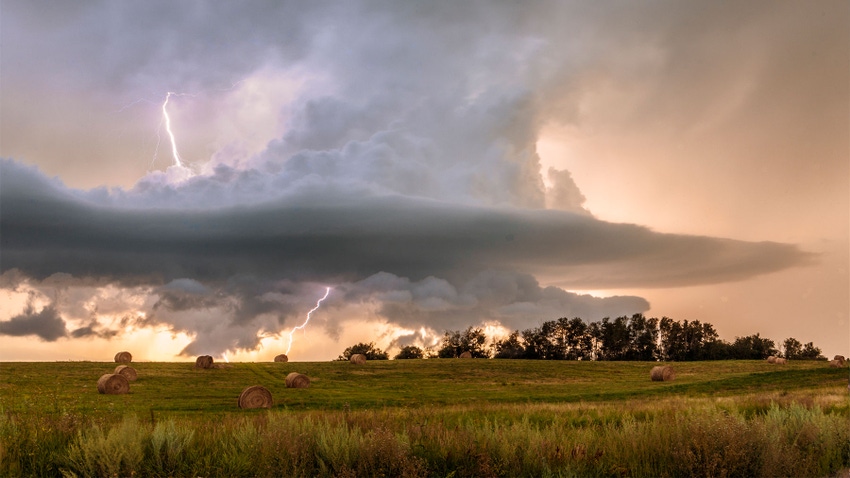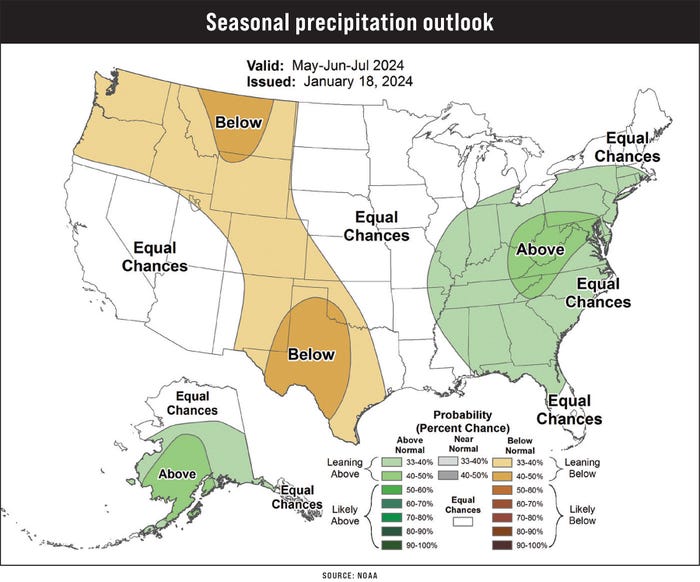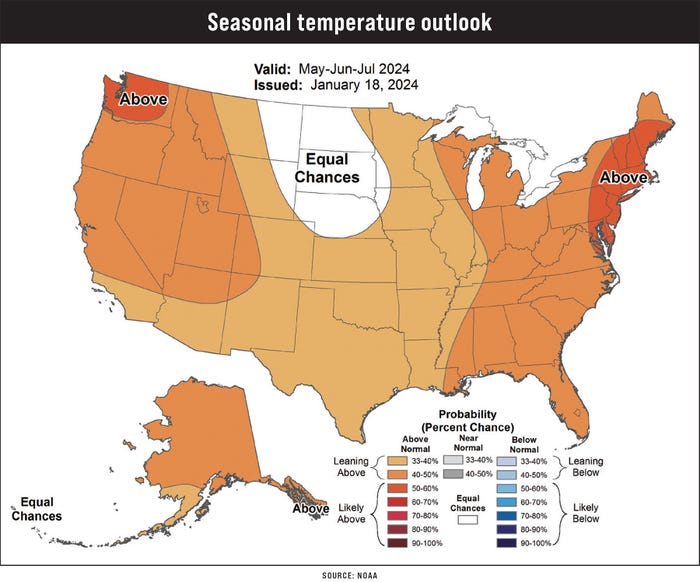
What’s the early word on this summer’s weather forecast? Farmer and meteorologist Eric Finkenbinder is betting on heat and rain.
“There likely will be enough rain chances to prevent drought. It just seems like we’re in a favorable pattern not to have drought. But tropical activity needs to be monitored this season," he said at the recent Mid-Atlantic Fruit and Vegetable Convention.
The National Weather Service released its May-June-July temperature and precipitation outlooks on Jan. 18, calling for good chances of above-normal temperatures and precipitation along the East Coast. Take a look:


Nothing is ever guaranteed with the weather, especially a long-term forecast. But Finkenbinder said the ingredients are there for this long-term outlook to be true. Here are three weather wild cards that he believes producers should keep an eye on:
1. El Niño to La Niña. It’s hard to believe that an abnormal warming or cooling of Pacific Ocean waters – El Niño and La Niña, respectively – have an effect on local weather, but data show these phenomena affect the weather everywhere.
Finkenbinder said current forecast models show a rapid transition from the current El Niño to a La Niña pattern by spring. When a La Niña forms, more hurricane development in the Atlantic Ocean is likely.
An El Niño generally means less hurricane development, Finkenbinder said, but last year’s active hurricane season — 20 named storms, ranked fourth for most named storms since 1950 — was abnormal.
One reason was weak prevailing winds from the West — the westerlies — that normally prevent storms from forming in an El Niño year.
2. Warm ocean waters. On top of the weak westerlies, the Atlantic Ocean was much warmer than usual last year. In fact, according to the National Weather Service, the ocean experienced record warmth, and so far, that trend is continuing this year, Finkenbinder said.
3. The Bermuda high. The biggest wild card in the recipe, though, might be the location of the Bermuda high pressure in the Atlantic.
This semi-permanent high pressure usually settles around the western Atlantic near Bermuda — hence the name. But not last year. Finkenbinder explained that the high pressure settled much farther east, which prevented many storms from hitting the East Coast. That’s good news.
The potential bad news, he said, is where the high pressure settles this year. If it reestablishes itself to the west, this could lead to hotter and wetter conditions along the East Coast because that will allow a lot of moisture to come north. It could then help set up land-falling hurricanes later in the season.
“So, if we have record-warm Atlantic water, and we’re moving into a La Niña … to me those are two red flags,” Finkenbinder said. “It could lead to a lot of wet weather coming our way. But for growers, that could mean more pesticides, fungicides, other things.”
Farmer perspective
Although weather forecasting is Finkenbinder’s main job — he is the chief meteorologist for ABC27 news in Harrisburg, Pa. — he still helps on his family’s 800-acre, 50-cow beef operation in Perry County, Pa.
This gives him a unique perspective on how the changing climate is affecting farms, including his own.
“Last year, our farm had one of its best crops ever. 2022 was the worst ever, and what we’re noticing is that storms are forming in clusters,” he said.

FARMER WEATHERMAN: Although weather forecasting is Eric Finkenbinder’s main job, he still helps on his family’s 800-acre, 50-cow beef operation in Perry County, Pa. Here, he talks to producers attending the Mid-Atlantic Fruit and Vegetable Convention in Hershey, Pa. (Photo by Chris Torres)
As Canada has gotten warmer over the years, the strong cold fronts that originate there and usually break streaks of hot and humid weather have become less normal. Instead of long lines of storms that used to form along those fronts, Finkenbinder said he is noticing a lot more clustering of storms, meaning some farms get rain while others don’t.
Winters are warmer and summers are hotter and longer, he said, especially at night.
“We're not looking at breaking record highs. We're looking at breaking record-high lows. It's basically warm nights,” Finkenbinder said. “Instead of getting those 50- and 60-degree nights, it’s now upper 60s, low 70s, a lot more nights now in the 70s. Plants really like that; weeds really like that, too.”
He is also seeing warmer and drier springs, a good recipe for haymaking.
“I had two-thirds of the farm's hay done before June 1 last year, which we normally don't get started until June,” Finkenbinder said. “If you get some dry May days, we get enough warmth. It just seems the maturity of the grass is happening a little bit sooner.”
But the warmer weather also brings more critters. “My family owns some woodlands and the amount of invasive species, and how quickly it is preventing regeneration of some of the desired trees, is alarming,” he said.
As he is on TV multiple times a day, Finkenbinder has become a local celebrity. But farming, he said, keeps him grounded, and he still tries to tailor forecasts to farmers when possible.
“I try to be very specific,” he said. “Most of the time it works, sometimes it doesn’t, but I think farmers need to hear more than just a chance for some storms or a chance of rain. I try to give them more timely forecasts. When we could see the rain, when it could end, how much we could see. Just those little details I think make the difference in our industry.”
And when he’s out doing fieldwork, other farmers are out there, too.
“When I cut hay and the local farmers see that, they're jumping on the tractors and trying to cut at the same time because they think, well, he must know something that we don't,” Finkenbinder said. “So, they'll try to get out there.
“This is my 21st year in broadcasting. I get to combine my farming background and what I do currently with meteorology, so it’s great.”
Read more about:
WeatherAbout the Author(s)
You May Also Like






